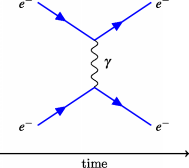3.5.8 Feynman Diagrams
In 1948, Richard Feynman (1918-1988) invented pictorial representations of the mathematical expressions describing the behavior of subatomic particles, which give a simple visualization of what would otherwise be a rather arcane and abstract formula. Theoretical physicists have increasingly turned to this tool which helps them undertake critical calculations. The diagrams are applied primarily to Quantum Field Theory, but they can also be used in other fields, such as solid-state theory.
In 1941, Ernst Stueckelberg (1905-1984) proposed that the positron is a positive energy electron traveling backward in time. Feynman used this interpretation and represented antiparticles as moving backward along the time axis.
The calculation of probability amplitudes in theoretical particle physics requires the use of rather large and complicated integrals over a large number of variables. These integrals do, however, have a regular structure, and may be represented graphically as Feynman diagrams.
A Feynman diagram is a contribution of a particular class of particle paths, which join and split as described by the diagram. More precisely, and technically, a Feynman diagram is a graphical representation of a perturbative contribution to the transition amplitude or correlation function of a quantum mechanical or statistical field theory.
Within the canonical formulation of Quantum Field Theory, a Feynman diagram represents a term in the Wick’s expansion of the perturbative S-matrix.
Alternatively, the path integral formulation of Quantum Field Theory represents the transition amplitude as a weighted sum of all possible histories of the system from the initial to the final state, in terms of either particles or fields. The transition amplitude is then given as the matrix element of the S-matrix between the initial and the final states of the quantum system.
The Feynman graphs and rules of calculation summarize Quantum Field Theory in a form in close contact with the experimental numbers one wants to understand. Although the statement of the theory in terms of graphs may imply perturbation theory, use of graphical methods in the many-body problem shows that this formalism is flexible enough to deal with phenomena of non-perturbative characters. Some modification of the Feynman rules of calculation may well outlive the elaborate mathematical structure of local canonical Quantum Field Theory.
In QED, a vertex always has three lines attached to it: one bosonic line, one fermionic line with arrow toward the vertex, and one fermionic line with arrow away from the vertex. The vertices might be connected by a bosonic or fermionic propagator. A bosonic propagator is represented by a wavy line connecting two vertices, while a fermionic propagator is represented by a solid line, with an arrow in one or another direction, connecting two vertices.
For example, the typical electromagnetic interaction, with the repulsion of two electrons exchanging a photon, can be represented by the diagram shown in Figure 3.1.

Figure 3.1: Feynman diagram of typical electromagnetic interaction with the repulsion of two electrons exchanging a photon.



















